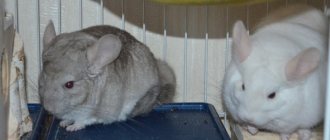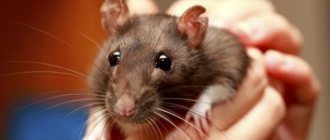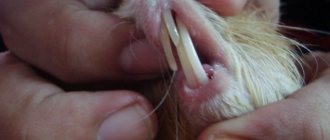The sounds of chinchillas are quite varied. They are social animals that love to socialize. They can make sounds similar to barking, squeaking, snorting, etc. This is how chinchillas transmit various messages to each other and establish interpersonal relationships.
Communication occurs through a wide range of intonations. To understand your pets, you need to clearly translate their speech.
However, out of all the variety, there are only a few basic sound “patterns”. By widely changing the tone and volume of their voices, chinchillas create their own special language of communication.
If you listen to them carefully, you will find a great similarity in emotionality with human speech. The experience of our nursery confirms this statement.
Over the years of observation, the most frequently repeated patterns were identified, which we present below.
Note: Some sounds are very rare. They are difficult to capture and are presented only in text. Animals are very individual. Some are talkative, others are silent or even grumpy. We also noticed that one animal is less talkative than a pair or more (one has no one to talk to).
Chinchilla sounds can be divided into the following categories:
- Anxiety, fear
- Anger, rage
- Children's communication
- Contact
- Pairing
- Protest, defense
Chinchilla sounds - anxiety and fear
Danger warnings (chinchilla barks)
If your pet encounters something it does not understand, it emits a series of short, intermittent screams (sometimes up to 15 in a row). This typical warning is heard as a “bark” (it is referred to as “the chinchilla barks”).
In the wild, a family member, noticing danger or something unknown, warns the entire group with such a sound. In this recording, you can hear concern about fireworks in the street.
If your recently purchased pet makes this sound, everything is fine, don't worry. In this way, he explores the new environment, gets used to it, strengthens himself psychologically, and encourages himself. As he gets used to his new home, he will calm down, become tame and more domestic.
Remember, external sharp sounds can be irritating for chinchillas. For example, being in a car and hearing a door slam, the animal will bark. For him, this is an unusual manifestation of the world, which is frightening. A sudden bang or a box falling to the floor will give the same reaction.
From time to time you can hear barking in your sleep. It is a slightly hoarse, muffled sound. It is unknown why this happens. We tend to believe that pets, like their owners, have dreams, perhaps even nightmares. People sometimes cry out in their sleep too.
Please take care of your charges, do not frighten them once again with something new, their psyche is very vulnerable!
Short alarms
Chinchillas are cowards by nature. When they hear a sharp loud noise, they get scared and almost always run away. Moreover, they run so selflessly that they forget to properly warn others about the danger. The result is a crumpled mutter like "Habababapp" that follows the furball as it runs away. When you see this, you will laugh for a long time!
DON'T SCARY PETS! They are likely to have a nervous attack or even die from such shock.
Fear and pain
In extreme situations, animals can make an alarming high-pitched sound. Usually this is done by individuals with a “subtle, vulnerable nature” or, on the contrary, who are too nervous.
In most cases, regular pet chinchillas do not do this. They are tamed, mentally stable, surrounded by comfort - they have nothing to be afraid of so much or suddenly.
Be careful - they can scream like that when they feel severe sharp pain (like a person in a state of shock). For example, when they get their paw stuck in a cage and can’t get out on their own.
Such screams also occur with internal, hidden pain (colitis, pancreatitis, etc.) - this means more a request for help than anxiety.
Take care of the safety and health of your pets, listen to them!
Shedding fur
Shedding fur should not be confused with the natural process of shedding.
A chinchilla should shed slowly and regularly. Therefore, if a chinchilla is completely bald, perhaps something has frightened it very much.
Rapid fur release is a defense mechanism used when a chinchilla feels trapped or threatened. Animals often use this in the wild, for example if a chinchilla is caught by a predator. But pet chinchillas can also shed fur if they are in a stressful situation.
Shedding fur is also a natural process and should not cause much concern to pet owners. If your hairless chinchilla is feeling normal, carefully inspect all exposed areas of his skin. You don't need to go to the vet or treat the bare skin area unless it starts to look painful.
Sounds of chinchillas - rage and anger
Animals are susceptible to these feelings from childhood. To survive you need to be the strongest. In not very milk-producing females with large litters, there is competition between the babies for mother's milk. Even one-day-old puppies are capable of showing aggression to establish dominance or gain access to food (mother's nipple with milk).
In such cases, the cubs can stand up on their hind legs, “fight” with their front legs, knock, grind their teeth, and even knock each other to the ground. No matter how scary it may look, as a rule, everything ends well. This is simply a clarification of relationships (building a hierarchy within the family).
Because of such family conflicts, the female is nervous, grumbling with displeasure, making a noisy, rough snort. If this does not help, she is capable of spraying restless kids with a stream of urine. This cools the dust.
When understanding this behavior, be careful. A grumpy mother will not miss the opportunity to splash you with urine if you get too close and fall under the hot hand.
"Family Disputes"
The energy of chinchillas sometimes interferes with their own behavior. The most spacious cage or display case still limits the space. This is felt more clearly when more than one tail lives together. As a result, “family scandals” may arise (as with people living with a large family in a cramped apartment). But more often than not, conflict is just an excuse to “let off steam” and defuse the situation.
Another striking example is untimely courtship. Here the male pesters the female (touches her with his teeth, as if trying to kiss her), but receives a sharp refusal and a stream of urine. The female tried to snort displeasedly. This did not help, we had to use heavy artillery. This is especially audible towards the end of the track.
The male, full of discontent, jumps up. Running around the cage ensues with verbal altercations expressed by dissatisfied grunting.
Sounds of chinchillas - babies
Kids communicate a lot - with mommy, with each other, with people. Cubs are generally more talkative than adults.
Feeding babies
To eat, a whole ritual takes place. The baby comes up to his mother, sniffs her face (like a dog puppy licks his mother’s face, asking for food). This is how the baby says to mommy: “I’m hungry, feed me.” He squeaks piercingly - loudly and sonorously (so that they would probably hear).
The mother responds with a soothing, caring grunt and licks the baby’s ears (as if stroking the head, calming the baby).
Having received the mother's approval, the cub climbs to the tummy, looking for a nipple with milk. He lies on his back under mommy's nipple to make it easier to drink milk. She cleans it, licks it, making it beautiful. The mother also stimulates the baby’s genitals in order to “start” the body’s bowel movements (cats and dogs also lick babies for this purpose). Meanwhile, the mother grunts caringly, and the baby squeaks happily.
Sleepy kids
As already mentioned, children communicate more and a little differently than adults.
Here, for example, are the sounds of a sleepy puppy sleeping near its parents. He was disturbed by his brother, who climbed in to warm himself.
The brother was too careless, the baby woke up and immediately spoke with a different intonation (similar to dissatisfied curses with complaints).
Observing babies, you can notice some behavioral similarities with human children. Children, they are children everywhere!
Sounds chinchillas make when making contact
Manifestation of relationship
When communicating closely, a couple in love makes a sound reminiscent of grunting with pleasure and squeaking at the same time - a soft, pleasant tone. This means closeness, good mutual attitude and a good attitude.
However, tails can grunt like this, being completely calm. We heard this when the female was sitting alone, as if she was sad about her friend (we put the male away for a while).
Perhaps this is expressing out loud good memories or thoughts about someone or something.
To attract attention
Chinchillas love and can attract attention. Whether they want to get something tasty, want to go for a walk, or are just bored, they attract attention to themselves.
“Hey, hey you, I want to tell you something” - this is how this sound can be translated.
We observed such sounds. One animal began to eat the found delicacy, huddling in a corner of the display case. The second one was lounging around, bored. Eating the treat was observed. The bored tail headed towards the glutton, squeaking: “Hey, buddy, what are you eating there? I’m coming to you, show me.”
And this female is looking for her soul mate. She wants to rub her face, exchange tenderness - “I missed you so much, hug me,” she seems to say.
Video on the topic
If the owner of an animal wants to understand his pet, then you need to listen to him more often
. This will help you figure out when the animal is scared and when it just wants to attract attention. Show care for your furry friend, and you will receive a lot of positive emotions in return.
The sounds of chinchillas are quite varied. They are social animals that love to socialize. They can make sounds similar to barking, squeaking, snorting, etc. This is how chinchillas transmit various messages to each other and establish interpersonal relationships.
Communication occurs through a wide range of intonations. To understand your pets, you need to clearly translate their speech.
However, out of all the variety, there are only a few basic sound “patterns”. By widely changing the tone and volume of their voices, chinchillas create their own special language of communication.
If you listen to them carefully, you will find a great similarity in emotionality with human speech. The experience of our nursery confirms this statement.
Over the years of observation, the most frequently repeated patterns were identified, which we present below.
Note: Some sounds are very rare. They are difficult to capture and are presented only in text. Animals are very individual. Some are talkative, others are silent or even grumpy. We also noticed that one animal is less talkative than a pair or more (one has no one to talk to).
Chinchilla sounds can be divided into the following categories:
Sounds chinchillas make when mating
Mating foreshadowing
When the female is ready to mate, she goes into estrus. The male courts her, making an unusual calling sound.
He cleans the floor under him and attracts the female by wagging his tail (like a dog when he is happy). This waving is called the "Wag Tail Dance."
If the female reacts normally, the male becomes more and more persistent. He approaches her with the goal of jumping in to cover her.
Sometimes the female is not ready for quick intimacy. She begins to defend herself, snorting with rage and anger (see above). It may bite him slightly or even cool his ardor with a stream of urine.
If the male is loyal and has a fairly gentle character, he “complains about the difficult lot of men,” squealing.
This squeal happens like this.
When a mother gives birth to babies, the partner is often separated so that there is no re-covering. Then he attracts her, leaning against the cage and whining pitifully like that.
Or like this.
After successful mating
In case of successful mating, the partner notifies about this in a rather interesting way. The signal resembles a loud hiccup in a hoarse voice and sometimes lasts up to several minutes.
After this, the couple relaxes together. They are dozing on the shelf of the cage, snuggling gently. At such moments they express complete idyll and peace!
Normal noise while eating
Before buying any rodent, you need to remember that they eat quite noisily, especially at night, when there is absolute silence in the house. Chinchillas are very active at night, so after playing and running around they immediately want to eat.
Chinchillas make a very loud noise at night when:
- They chew their house and shelves
- They chew on wood and mineral stones
- Eating crackers and sweet sticks
After reading this article, I hope that it will be easier for you to distinguish the sounds that your pet makes and if he asks for help, then you will understand it. It is very important to recognize your chinchilla's requests so that its life is comfortable, as a result of which it will make less noise at night and disturb you.
Before buying a chinchilla, you need to remember that the chinchilla will live in a separate room from where the sound will not be heard, or you will have to get used to noisy nightlife. Of course, it is possible to train a chinchilla to sleep at night so that it makes less noise, and we have a separate article about this.
Sounds of chinchillas - protest and defense
"You hurt me"
This is how tails whine when they are irritated or embarrassed by others. They do this all the time, from birth. The sound shows defenselessness, vulnerability, and actually speaks about the situation of the victim. It is analogous to the expression “pressure on pity.” If this does not work, more stringent methods are used.
If you pick up your pet and notice that he is whining, stop immediately! Otherwise, your actions will not be a manifestation of love, but violence. Try showing your kindness in a different way. Your actions should be mutually pleasant. Perhaps your friend is not yet mentally prepared for such a turn of events.
Protest
When an animal feels oppressed from the outside, it grumpily swears, making it clear - “Hey, I don’t like your behavior! I'm against! Stop it!”
The reasons can be varied - a queue for a bowl of food, pestering by a boyfriend, inappropriate playfulness, etc.
If this sound does not produce results, the chinchilla will begin to display rage or anger.
What to do: provide comfortable and safe conditions
The animals are most active at night. They sleep most of the day. Individuals living in pairs or groups prefer to hug or climb on top of each other.
Even a soft knock can wake up the animal and put it into an excited state. If you choose a chinchilla as a pet, then you will have to adapt to its rhythm of life . Since these rodents like to get ready for bed at a certain time, they will need to feed and clean the cage according to a schedule.
If the baby lives alone in a closet, then most likely he will choose the sleeping position - lying on his belly. Seeing a pet lounging on its side, you can be sure that the animal is accustomed to a person and completely trusts him.
Chinchillas are nocturnal creatures, spending most of the day sleeping. It is important to remember, no matter how long the animal sleeps, you cannot wake it up!











